Being a part of a SaaS startup means you really understand what it’s like to operate as a small (like, really small) company, especially in the beginning. If you’ve never stepped foot in the corporate world before (or even if you have), wooing “big arse” companies can feel incredibly daunting. Luckily, we’ve got some folks who are going to share the playbook on how (and how not to) engage with large organizations.
Jonathan Lehr, Managing Director at Work-Bench chats with three executives of gigantic companies with offices all around the world: Tom Carroll, EVP at RR Donnelley; Scarlett Sieber, SVP, Open Innovation at BBVA; and Joyce Shen, Director of Emerging Technology at Thomson Reuters. In this session, they delve into the dos and don’ts of starting and cultivating the relationships that lead to those monster enterprise deals.
Check out the full transcript below!
If you want to see more sessions from SaaStr Annual, we’re releasing a new one each week. Subscribe here to be notified. And be sure to grab your tickets to the next SaaStr Annual NOW.
TRANSCRIPT
Jonathan Lehr: Hey, everyone. I’m Jon Lehr, Managing Director of Work Bench. We’re an enterprise funding community based in New York. Our mantra has always been that amazing things happen at the intersection of suits and hoodies, which is why I’m so excited for our panel today on how startups can better work with corporates.
Before we kick off, I want to make sure everyone’s awake. Raise your hand if you’d love to sell into one of our esteemed panelists. Awesome. We’re little short on time today. We’re going to skip intros and dive right in.
Tom, I’m looking at you. RR Donnelley is a 150 year old company, and yet you’ve done some amazing work with startups lately, even some that are super early stage and don’t have many customers. Walk us through the why and then get into the how a little bit.
Tom Carroll: I think the simple answer is this. We’ve been around 150 years. The City of Chicago burned down, the Great Depression. The minute you start thinking, “I know everything,” you’re lost.
For us, after 150 years of being around, we were sitting down and looking and going, “A lot of media that we are engaged with is enabled through the digital world.” The question for us is how do we participate in that?
Startups are a simple way for us to be there, for us to participate on the cutting edge. It was helping the founding of Work Bench, Oracion is a great example of a company that we sat down and looked at what they offered from a pharmaceutical perspective, which is in a healthcare market which is a damn train wreck right now.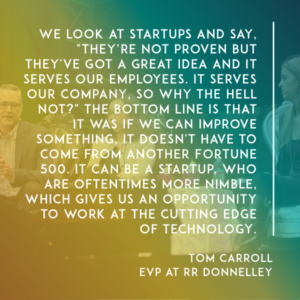
One of the things that we sat down and thought is, “Here’s a startup. They’re not proven. They’ve got a great idea. It serves our employees. It serves our company, and why the hell not?” That was us taking somewhat of a risk, but bottom line is that it was, if we can improve something it doesn’t have to be us, it doesn’t have to be IBM, it doesn’t have to be another Fortune 500.
It can be a startup and a lot of times startups are more nimble, and therefore it gives us an opportunity to work at the cutting edge of technology.
Jon: Awesome. Joyce, let’s look over to you. Your role at Thomson Reuters involves really scouting and then vetting startups internally. Playing off Tom’s point, how do you think about risk for an early stage company? How early can you go?
Joyce Shen: We go really early. To your point it’s the activities, and the pace, and just the evolution of emerging technology has changed so rapidly that we have to be able to understand what’s coming in the next 5 to 10 years and plan our emerging tech strategy, plan how we engaged with early stage companies to do co-creation and market development.
We’ve worked with companies that have 10 people all the way to companies that have raised Series A, Series B, and of course there’s the large tech companies. But I think what we are looking for from the smaller companies are really the external insights. How do we build quickly? What are some of the things that you are doing in terms of capability that can allow us to fill the gaps that we can’t find in large companies?
How do you advise us to go and look at our entire IT infrastructure and our product innovation cycle for next 2 years, 5 years, and 10 years?
Jon: When you are looking at some these 10 person companies, how are you finding them out there? Are they coming to you? Are you searching for them?
Joyce: It’s a mix. Work Bench is a great partner and many VC friends here. We do monthly, quarterly discussions with the ecosystem to really share what Thomson Reuters is looking for from emerging tech perspective. What are the enterprise technology areas we’re interested in?
What are the product innovation initiatives that both encompasses technology and business model that we are looking for? Through that communication our partners like you understand what we’re looking for, what fits the startups, then we facilitate that conversation. The other part is really there are projects that we work on that we can’t share a lot of information.
Or we just simply don’t know where it’s going to go. Example, I think Fintech or some of the more emerging tech areas where we internally as a large company need to have time to develop that visibility, that clarity. Part of the learning is to proactively go out and identify startups that have those specific capabilities.
Also the understanding of the market, so that we can find almost like a board of advisors that allow them to come in early in the game, but also allow us to really develop a holistic view of who can we partner in the future? Who could be the potential vendors? How do we potentially integrate with large companies that we’ve been working with? And so forth.
Jon: Scarlett, if a startup wants to get in touch with you what’s the best way for them to reach out? How can they understand the pain points that you may be looking for solutions for?
Scarlett Sieber: There’s a few different ways. First I want to highlight on some of the things that Joyce was talking about. The way that I view my role and I’m a recovering entrepreneur, so I think that I think about it a little bit differently than most corporates. Specifically in New York it’s being the foot soldier on the ground.
It’s a lot of proactive and reactive as well. Being part mentors, and all these accelerators, and going to enterprise meet ups and things like that. Just being part of the ecosystem and hearing what’s going on.
The best way is actually understanding what we’re doing and what we’re looking for. You can go to the corporate websites and see the high levels, going to events like this and hearing the areas that we’re really interested in and concerned about is one of the best things.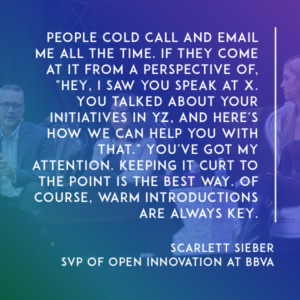
I think that we can start focusing later on, if you want, about the ways that people go about now. They’re really not effective. People cold reach out to me all the time. If they come at it from a perspective of, “Hey, I saw you speak at X. You talked about your initiatives in YZ, and here’s how we can help you with that.” You’ve got my attention.
Keeping it curt to the point, not sending me six paragraphs is the best way. Of course, always you’re going to hear this from any VC or anyone else, warm introductions are always key.
Jon: Tom, if someone doesn’t have a warm introduction to you, what’s a way that they can understand what’s going on at Donnelley and reach out?
Tom: Well, I think they’re simple stuff. You can look at every function inside of a company. What’s going for IT? What’s going on for HR? What’s going on in finance? What’s going on with legal? You could apply that across many, many industries. You can specifically look and go inside the industry.
You can go, “OK, in industry, that’s late income paper for 150 years is in transition.” What the hell is that transition? When you show up, you need to have a conversation with me about a business issue that I got going on, that I could identify with what you’re saying versus…
Let me tell you about my tech. Let me tell you about this whiz bang shit that I did, that I’m sitting and going, I have no idea what you’re talking about. It’s not settling the business issue that I’ve got, so now you’re wasting my time.
For me, do your homework before you show up because that is going to get you in the door with me. You’re speaking a language that’s meaningful for myself or another business leader in the company. That then is solving the business problem versus I’m there to listen to some whiz bang tech you designed I could give two craps about.
Joyce: I think, if I may add, it depends on the audience. Specific example, a London based company, five people. They reached out on LinkedIn, very specific email on, “This is what we do. This is the content that we have. This is how we’re getting our content. This is what we want to talk about.”
I read my LinkedIn emails. Now they’re working with one of our business teams in financial risk to partners. I think that the audience is really important. If you’re talking to somebody like me, the other conversation where I know the landscape of big data. I know the landscape of cloud. I know the marketing tech. I know the capabilities out there.
Be specific what exactly you’re offering. How does it fit into the enterprise stack and how you differentiate. That quickly helped me to understand, “OK, you know, if it’s cloud, within our data center team, here’s the person that you should talk to,” or “Here for marketing tech. Is it digital tech? Is it market development team?” or so forth.
Depending on the audience and how technical you are, you certainly have to tailor your message and how specific you go on the technical and the business capability that you offer so that help you by helping us.
Jon: At the same time, Scarlett, you just mentioned before to keep it short. How are you supposed to make sure that they’re showing that they understand your pain point? Here’s how we differentiate in a very crowded landscape, then the same time, keep it very concise. What have you seen work well?
Scarlett: It’s knowing your audience, right? Part of that is saying, “Here’s the problem. Here’s how we solve it.” My focus is if you can intrigue me and I want to hear more, then you can go into all these other details.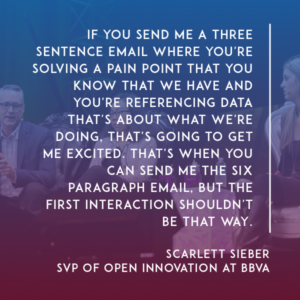
If you send me a three sentence email where you’re solving a pain point that you know that we have, you’re referencing data that you’ve seen about what we’re doing, that’s going to get me excited. Then you can send me the six paragraph email.
The first interaction shouldn’t be that way. The other thing that I see a lot too is I get very nervous when people automatically assume that we’re a distribution channel. We have 15 million customers, operations in over 30 countries. It’s very easy to tweak that out within the first one or two emails.
You have to really think about how am I really going to change your business and impact your bottom line and not just use as a distribution channel to have access to a bunch of customers? Which I think a lot of companies and startups aren’t really understanding right now.
Tom: I want to jump in because I look and go, the tech is one thing. If you’re going to show up, you’re going help us solve the business problem. We go it. If you show up like an idiot in the work environment, we’re not interested in talking to you. You don’t understand the culture that you’re in. You don’t understand, our environment’s very aggressive about getting stuff done.
You’re a drawer. You’re going to come in and draw pictures for us. You’re going to talk for hours about stuff that we’re sitting there and going, “How the hell is this going to solve anything?”
Or you’re not driving the result that we’re looking for quickly, we’re going to look and go, “Your interpersonal approach to the company is misaligned to the culture that we need you to work within.” This whole simplicity.
I’m with you on emails. If you make me read something more than one screen, you’re out. I’m not even reading. You’re done. I will never talk to you. My other is that you link me in, and then you want to sell me your shit. It’s like, “No.” I’m not interested in that. All I know is you saw me on LinkedIn, you know my background, you sent me a bunch of stuff, and now this is a generic sales call.
You’ve not studied anything about what’s going on, or my pain points. This gets into culturally, how do you show up in my organization? I expect certain things out of people that come work for me.
Scarlett: Part of that too is doing your research. What is really frustrating is when you get that generic email, which you know has been sent to a million people, because I’m not going to take my time to look at that. Joyce uses LinkedIn. I use Twitter.
Those things can be easily found. People who send me DMs on Twitter where I connected to, I will have that meeting with them because they know me. They took the time to read what I was talking about. I’m going to connect with them in a different way.
LinkedIn for me is very overwhelming. There’s so many messages that I just get blinded by that. Twitter is the most effective thing because I check it every day. It’s direct. It’s 140 characters, so I’m going to have that conversation. That’s just knowing your audience and taking the time to really know who you’re speaking to, and what gears them up.
Joyce: The other thing too, how you balance conciseness with how to target the right customer is…using buzzwords is great. You know what the big category you are, but let’s just take the example of big data.
It doesn’t really help me anymore to know what big data is. It doesn’t really help me to know. It’s just data visualization. What part of that value chain do you fit in? If I can help pinpoint where you are in that workflow or value chain in the spectrum big data or Fintech.
However you want to dice that up, it helps me to understand where you fit in. Is it a vendor relationship? Is it a partner relationship? Is it you align with a product innovation project that perhaps we need help to work on?
It doesn’t have to be a huge paragraph, but clearly understand where you play in a specific stack will help.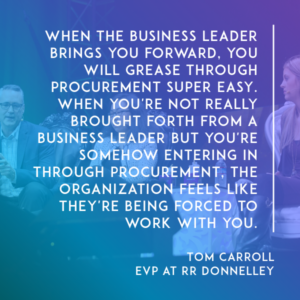
Tom: The other piece of that is in our company when the business leader brings you forward, you will grease through procurement super easy. When you’re not really brought forth from a business leader, but you’re entering somehow in through procurement, the organization has that sense of I now need to use you.
I’m being forced versus I got a business problem, I have a partnership. I now want to work with you. I think you’re capable, and I will go tell procurement what I need, and what I want, and what I’m willing to pay for it.
I note with a lot of the start ups, the whole getting bogged down inside of procurement becomes an issue. For our company, that doesn’t happen if you got sponsorship from the business.
Jon: Joyce, playing off that, let’s say you’ve done your homework. They’ve send you the good LinkedIn message. You have the meeting, and you’re in with the business person that can really have the pain point that they’re going to support. How can a startup here nail that meeting and make sure that they’ll want to help you accelerate along procurement and keep things moving?
Joyce: Assuming that you found advocate or champion like me. Some startups are very proactive. They ask “Who are the audience? Who are the people attending the meeting? Is it 30 minutes? Is it 15 minutes? How should I do that?” Ask questions.
Assume the business has some understanding of the technology and the space we’re interested in. Today, there is so much information about certain technologies, certain business area that you don’t have to describe. This is the big data market. This is the Fintech market. This is the payment market. We know how big it is. We know where the disruptions are.
Here is the ecosystem. We know you know these are the large tech companies. These are the large players. Here is where we fit in from ecosystem perspective. Here’s where we fit in from a technology stack perspective, and then go into the demo.
Jon: That’s how the meetings go really well. Scarlett, what happens when people tank? Walk through what to avoid.
Scarlett: In the introduction or when you’re far along in the process already?
Jon: Both in the Intro and then if they end up getting a meeting.
Scarlett: Part of it is not reading signals. First of all with the intro, we already talked about this. There is a company here who has emailed me nine times in 72 hours from different people. That just does not work. I’m forward about that, and I will not talk to you after that point. It’s being on the same page.
Moving forward and once you get pass the first initial meetings, and you talked about having the evangelist, which is extremely important. It’s making sure that depending on what your product is, you have those right people in the meeting.
It’s pushing and not in an aggressive way but saying, “I need to make sure that tech…I need to make sure that risk is in this meeting,” and asking for it. Going back to what you were saying.
When that doesn’t happen, I’ve had a handful of companies who get stuck in the middle where there’s not really much happening. I’m doing a million different things. I can’t sit there and hold hands with every single company.
The ones who are coming at me and saying, “Scarlett, I’ve been sitting here for six weeks and nothing’s happening. What’s going on?” It’s not being afraid to say what you want to do and what you want to happen.
The people who just let that slide by are going to be sitting in the pipeline and nothing is ever going to happen. The ones who are proactive and saying, “I need your help. Let’s get this going.” I’m going to be championing for you. I’m going to try and make that happen.
Jon: Tom, when a company is working with you, how do they balance persistence to drive things forward versus bordering on harassing with nine emails?
Tomt: I’m actually easy because if you can bring me something that’s valuable, I want to meet with you. Oracion’s a great example. The CEO calls me up, “Here’s how our product is, I want to come talk to you.” I was like, “Hell yeah.”
I’ve had the same thing where the 10 million emails from the same company. You’re at the point that even if they called, I’d not want to talk to them because now, they’ve just irritated the crap out of me.
It is something that for me, I’m looking and going…I run HR for 68,000 person organization that’s global. I run Global Affairs. I run postal. I run advise at Work Bench. I’m running the split up of our company into three companies. If you cannot make your interaction with me simple, effective, and helpful, I’m out.
Joyce: Your point about companies stuck in the middle. I wouldn’t be in my role if I didn’t love working with startups, and help our large company to become better in how we innovate and how we serve our customers.
For the company that’s stuck in the middle, one of the specific ways about being helpful is there are companies that send these monthly or twice a month, short updates, but very to the point. These are the milestones we have achieved. Here are the customers we’ve got. Here are the partners we got, and here is the help we need.
By the time you read through, there may be keywords that come out. If you partner with a company that we’re a partner with, I’m interested to know where there is a three way synergy. If I’m part of a community building innovation, there may be some help I could provide you.
For companies that try to move through. Having that updates that are very targeted to move you along. Still keep you in the top of mind. That has been helpful. I can forward that to the right business folks.
Scarlett: That’s 100 percent right. It’s the same emails that you send to your VCs you know, your monthly, or quarterly, depending how you do it. Having me have assess that because it’s the same thing. I come from startups. My goal is to help you. At the end of the day BBVA is paying for me, but I want to make sure that it’s a worthwhile relationship for you.
Even if it’s not within BBVA, based off of that email, I can say “Oh, you are going after those customers. I know three people who could be a great resource for you.” It’s just giving the top line but not. It’s a delicate balance. You have to feel what makes the most sense.
Tom: I think too, for me, do not mistake activity for result. A lot of the written documents that I get, wellness is a great example. Our company can make your employees well, and we’ll save you millions of dollars. Anybody could write that. When you actually start digging into the actual results, you don’t see it.
Do not mistake I’m involved in a lot of activity as an actual result. Frankly, I’m looking for what are the results that the product that you’re selling me has caused.
Jon: Aside from pure results. Are you looking for customers, VC funding, the type VC that backs a company. What are the key metrics that you’re looking for?
Tom: You get into the whole funding conversation. I get into the product. I’m looking at your product and go, “OK, your product is a recruiting product.” I want to know how many people. The companies that are using you have they actually recruited using the product that you’ve got and not gotten sued because it violates federal laws around discrimination.
If it’s healthcare, I want to know if you’re going to tell me about you got all these people that you’re making well. I’m dying to see the metrics that you’re using on that. When dug into, it was, you mailed my employees that have diabetes a letter.
I was like, “Oh, that is such bullshit.” I am a bad swearer. I’m trying not to swear up here. For me, those metrics are the things that when you dig down and you find it’s bullshit beneath all the activity. I literally canned a $5 million contract, because it was like, “No, no, no.”
I can send my own letter, and call that effective. Those are metrics that I look for. Depending upon, is it healthcare, is it recruiting? Let’s be honest. It all ties back to, is this somehow helping me either get more customers, or cut cost, save money?
Jon: Joyce, what are some things that startups have to consider when working within organization of your scale in terms of the product. In terms of support that is different than working with a 10 person startup that they’re selling into?
Joyce: That’s a good question. The larger startups that have more resources, obviously they have a more sophisticated engine in helping the customer, helping the partnership side of the discussion.
I think at the end of the day, that doesn’t really matter. Back to your earlier question is it’s all about how you optimize the mapping, between the startups and enterprise. There are a set of initiatives, engagement models on the enterprise side.
Then the startups have a set of strategies that you want to reach your end customer, whether it’s to sell, whether to partner, or do something else. It’s how do you optimize that mapping. Attributes like, where am I in the funding stage? To me, it’s somewhat a proxy to how scalable you are.
There are certain groups within Thomson Reuters, love to work with 10 person startup. Because they’re product innovation, they want to work. They don’t exactly know what they’re building. They want to co-create.
We have infrastructure in place from a contracting perspective, from a know how perspective. We know how to work with those companies that are still evolving because we are evolving those teams.
But then there are teams where, especially in the enterprise technology side where you have cloud, or big data, or some of the infrastructure side of things. You tend to want work with a larger startups because the first question that comes out is what we have petabytes, petabytes of data. We have 10,000 people in the tech organization, how scalable it is.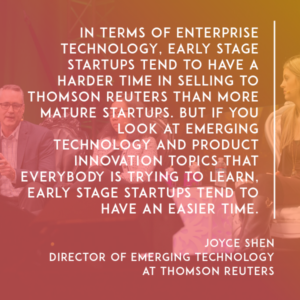
If you look at the startups, you tend to fall at a spectrum that earlier startups for enterprise technology tend to have a harder time in at least selling to Thomson Reuters. More mature startups focus on enterprise technology solutions have an easier time.
But if you look at more emerging technology, product innovation topics that everybody is trying to learn, then, the earlier stage startups tend to have an easier time.
Scarlett: We’ve used that. The earlier stage stuff is exciting to me. That’s my expertise. That’s what I care about. You’re getting a lot more of the real thought at that stage, but there has to be a filter because there are so many. You only have so many resources. We have a competition that we help push them through the pipeline.
The way that I view my role and my team’s role is making you get over all the stuff you don’t want to deal with, the regulatory stuff, the risk stuff, the compliance stuff. That stuff takes a long time. You can spend an hour a week with our team and get a year’s worth of information during that.
Let’s go with what’s happening next. Back to Tom’s question. I don’t care about the funding. I don’t care about the funding because the VC’s metrics are very different than my metrics. It’s a completely different relationship. If you’ve raised 10 million bucks, congratulations.
Doesn’t that mean you are the right business for me; it means you have a strategic alignment with what I’m looking for, and you’re doing something different. There are two different categories. There’s stuff that’s going to have an immediate impact on my business. There’s stuff that’s going to have more along tail.
I’m personally interested in the more along tail stuff, but there are places for the earlier stage stuff that’s happening right in having an immediate impact in your business. I can make those introductions, but that’s not what I focus on.
Jon: Awesome. We are just about out of time. Let’s get one line closing thought from each of you with the final tip for the audience.
Tom: Final tip. It’s not that hard to work with big companies. Don’t make it overwhelming in your head.
Joyce: Help you by helping me be tactical and strategic. Find where the multiple touch points are and then use that in different ways.
Scarlett: I already said it. Do your research and be genuine because the psychology component of all this can have a huge impact on the success of your business.
Tom: Thanks everyone. Let’s give a round of applause.
